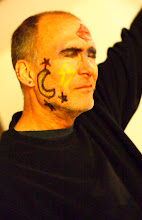 Without these photos I wouldn't notice a lot of the incremental changes, and probably wouldn't remember the process a few months from now. The photo above is from two weeks or so ago, and the one below from last week. Suzuki-san, the master carpenter, has put in the kamoi, the lintels that will form the frame of both the ranma, the horizontal transoms above them, and the shoji doors below that will enclose the tatami room. He seems to spend most of his time working on all the fine parts of this room, while the apprentice is finishing up all the plasterboard installation in the rest of the house.
Without these photos I wouldn't notice a lot of the incremental changes, and probably wouldn't remember the process a few months from now. The photo above is from two weeks or so ago, and the one below from last week. Suzuki-san, the master carpenter, has put in the kamoi, the lintels that will form the frame of both the ranma, the horizontal transoms above them, and the shoji doors below that will enclose the tatami room. He seems to spend most of his time working on all the fine parts of this room, while the apprentice is finishing up all the plasterboard installation in the rest of the house. Ranma can be very elaborate; some in old temples and other buildings feature intricate carvings, and more simpler ones are just latticework. Ours--the ones we're using from the old house--are even more simple, built of horizontal shoji frames that can be opened or closed, in the same dimensions as the doors below them. But they still work the same way, helping with air circulation and light. The windows to the right will also have sliding shoji so the room will be bathed in the softest possible light when they're all closed. (Protective padding has been placed on all the posts and beams that will eventually be visible to prevent any accidental damage.)
Ranma can be very elaborate; some in old temples and other buildings feature intricate carvings, and more simpler ones are just latticework. Ours--the ones we're using from the old house--are even more simple, built of horizontal shoji frames that can be opened or closed, in the same dimensions as the doors below them. But they still work the same way, helping with air circulation and light. The windows to the right will also have sliding shoji so the room will be bathed in the softest possible light when they're all closed. (Protective padding has been placed on all the posts and beams that will eventually be visible to prevent any accidental damage.)Another view of the very temporary color of grey undercoat for the exterior mortar, this looking up from the beach.






















